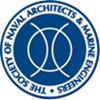启用t型尾板及尾板以改善高速渡轮乘客的舒适度
IF 1
4区 工程技术
Q3 ENGINEERING, CIVIL
引用次数: 5
摘要
100米左右的高速渡轮以40节左右的速度航行时,会引起乘客严重的头浪不适。这是由于遇浪的频率、船体对遇浪的最大响应频率和乘客最大不适感的频率都在相似的范围内。本文考虑了采用主动t型翼和尾板控制头浪中的纵摇和升沉所获得的效益。采用时域高速条形理论对船舶运动响应进行时域数值积分计算,包括非定常控制作用。这避免了识别传递函数的需要,计算的时间响应包括非线性船体浸入项。最大的乘客垂直加速度发生在前方位置,最好由位于前方的t型翼与主动船尾标签结合使用来控制。考虑了各种反馈控制算法,发现俯仰阻尼控制能最大程度地改善乘客在前方位置的舒适性。在自适应和非线性模式下运行,使控制偏转在所有条件下都最大化,并可以根据国际标准化组织(ISO)对90分钟海上通道MSI计算的建议,在3米的海面上减少乘客晕动病发生率(MSI)高达25%。本文章由计算机程序翻译,如有差异,请以英文原文为准。
Operation of T-Foils and Stern Tabs to Improve Passenger Comfort on High-Speed Ferries
High-speed ferries of around 100 m length cruising at around 40 knots can cause significant passenger discomfort in head waves. This is due to the frequencies of encountering waves, of maximum hull response to encountered waves and of maximum passenger discomfort all falling within a similar range. In this paper, the benefit obtained by fitting active T-foils and stern tabs to control heave and pitch in head waves is considered. Ship motion responses are computed by numerical integration in the time domain including unsteady control actions using a time domain, high-speed strip theory. This obviates the need to identify transfer functions, the computed time responses including nonlinear hull immersion terms. The largest passenger vertical accelerations occur at forward locations and are best controlled by a forward located T-foil acting in combination with active stern tabs. Various feedback control algorithms have been considered and it is found that pitch damping control gives the greatest improvement in passenger comfort at forward positions. Operation in adaptive and nonlinear modes so that the control deflections are maximized under all conditions give the greatest benefit and can reduce passenger motion sickness incidence (MSI) by up to 25% in a 3-m head sea on the basis of International Organization for Standardization (ISO) recommendations for calculation of MSI for a 90-minute seaway passage.
求助全文
通过发布文献求助,成功后即可免费获取论文全文。
去求助
来源期刊

Journal of Ship Research
工程技术-工程:海洋
CiteScore
2.80
自引率
0.00%
发文量
12
审稿时长
6 months
期刊介绍:
Original and Timely technical papers addressing problems of shipyard techniques and production of merchant and naval ships appear in this quarterly publication. Since its inception, the Journal of Ship Production and Design (formerly the Journal of Ship Production) has been a forum for peer-reviewed, professionally edited papers from academic and industry sources. As such, it has influenced the worldwide development of ship production engineering as a fully qualified professional discipline. The expanded scope seeks papers in additional areas, specifically ship design, including design for production, plus other marine technology topics, such as ship operations, shipping economic, and safety. Each issue contains a well-rounded selection of technical papers relevant to marine professionals.
 求助内容:
求助内容: 应助结果提醒方式:
应助结果提醒方式:


